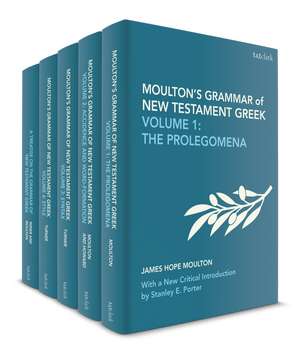Moulton's Grammar of New Testament Greek
Autor James Hope Moulton, Stanley E. Porteren Limba Engleză Quantity pack – 27 noi 2019
Preț: 2845.50 lei
Preț vechi: 3308.72 lei
-14% Nou
Puncte Express: 4268
Preț estimativ în valută:
544.52€ • 562.59$ • 452.96£
544.52€ • 562.59$ • 452.96£
Carte indisponibilă temporar
Doresc să fiu notificat când acest titlu va fi disponibil:
Se trimite...
Preluare comenzi: 021 569.72.76
Specificații
ISBN-13: 9780567662422
ISBN-10: 056766242X
Greutate: 3.58 kg
Editura: Bloomsbury Publishing
Colecția T&T Clark
Locul publicării:London, United Kingdom
ISBN-10: 056766242X
Greutate: 3.58 kg
Editura: Bloomsbury Publishing
Colecția T&T Clark
Locul publicării:London, United Kingdom
Caracteristici
2,676 pages, 99 chapters and five volumes present and analyse Moulton's classic text, forming an invaluable resource for students of New Testament Greek
Notă biografică
James Hope Moulton (1863-1917) was a Wesleyan minister and held various academic appointments, including as Greenwood Professor of Hellenistic Greek and Indo-European Philology at the University of Manchester, UKWilbert Francis Howard (1880-1952) was a pupil of James Hope Moulton and authored Christianity According to St. John, The Romance of New Testament Scholarship, and The Fourth Gospel in Recent Criticism and Interpretation.Rev. William Fiddian Moulton (1835-1898) was an English Methodist minister, Biblicalscholar and school instructor, where he taught Greek grammar.Nigel Turner was Reader in Theology at the University of Rhodesia, Zimbabwe. Stanley E. Porter is President, Dean and Professor of New Testament, McMaster Divinity College, Canada.
Cuprins
1. A GRAMMAR OF NEW TESTAMENT GREEK: VOLUME 1: PROLEGOMENACritical Introduction and Bibliography - Stanley E. Porter 1. General Characteristics 2. History of the 'Common' Greek 3. Syntax: The noun 4. Adjectives, Pronouns, Prepositions 5. The Verb: Tenses and Modes of Action 6. The Verb: Voice 7. The Verb: Moods 8. The infinitive and Participle 9. Additional notes Index to Quotations Index of Greek Words and Forms Index of Subjects Appenda to Indices2. A GRAMMAR OF NEW TESTAMENT GREEK: VOLUME 2: ACCIDENCE AND WORD FORMATIONCritical Introduction and Bibliography - Stanley E. Porter Part One: Sounds and Writing1.The Alphabet2. Modern Printed Greek3. Sounds and Orthography Part Two: Accidence4. Definite Article5. Nouns6. Adjectives7. Adverbs8. Numerals9. Pronouns 10. Verbs Part Three: Word-Formation 11.Word-Composition 12. Prepositions 13. Word-Formation by Suffixes 14.Appendix 15. Index I: Quotations 16. Index II: Words and Forms 17. Index III: Subjects3. A GRAMMAR OF NEW TESTAMENT GREEK: VOLUME 3: SYNTAXCritical Introduction and Bibliography - Stanley E. Porter1. Substitutes for Nouns in Subject, Object or PredicatePart One: Word Material for Sentence Building2. The Gender and Number of Nouns3. The Comparison of Adjectives and Adverbs4. Vocatives5. Substantival Article and Pronoun6. The Verb: Voice7. The Verb: Aspect and Tense8. The Verb: Moods: Indicative and Subjunctive9. The Verb: Moods: Optative10. The Verb: Noun Forms: Infinitive11. The Verb: Adjective Forms: ParticiplePart Two: Word Groupings Defining a Noun or Adjective12. The Adjectival and Predicative Definite Article13. Attributive Relationship: Adjective and Numerals14. Attributive Relationship: Pronouns and Pronominal Adjectives15. Attributive Relationship: SubstantivesPart Three: Word Material Which Defines a Verb16. Predicative Use of Adjectives and Adverbs17. Case Additions to the Verb: Without a Preposition18. Case Additions to the Verb: With a Preposition19. NegativesBook Two: The Sentence CompletePart One: The Ordinary Simple Sentence20. Subject and Predicate: Apparent Absence of Subject21. Subject and Predicate: Apparent Absence of the Verb "to Be"22. Congruence of Gender and Number23. Subordination of Clauses24. Inconsistencies Between Main and Dependent ClausesPart Two: Connections Between Sentences25. Coordinating Particles26. Irregularity of Subordination27. Word OrderIndex of ReferencesIndex of SubjectsIndex of Greek Words4. A GRAMMAR OF NEW TESTAMENT GREEK: VOLUME 4: STYLECritical Introduction - Stanley E. Porter 1. Sources Behind the Gospels 2. The Style of Mark 3. The Style of Matthew 4. The Style of Luke-Acts 5. The Style of John 6. The Style of Paul 7. The Style of the Pastoral Epistles 8. The Style of the Epistle to the Hebrews 9. The Style of the Epistle of James 10. The Style of 1 Peter 11. The Style of the Johannine Epistles 12. The Style of Jude and 2 Peter 13. The Style of the Book of Revelation Subject Index Index of Names Index of Semitic, Greek and Latin Words5. A TREATISE ON THE GRAMMAR OF NEW TESTAMENT GREEK1. Introduction: On the Object, Treatment, and History of N.T. Grammar -- Stanley E. Porter Part I: On the General Character of the N.T Diction 2. Various Opinions Respecting the Character of the N.T. Diction 3. Basis of the N.T. Diction 4. Hebrew-Aramaic Colouring of the N.T. Diction 5. Grammatical Character of the N.T. Diction Part II: Accidence 6. Orthography and Orthographical Principles 7. Accentuation 8. Punctuation 9. Unusual Forms in the First and Second Declensions 10. Declension of Foreign Words: Indeclinable Nouns 11. Declension and Comparison of Adjectives 12. Augment and Reduplication of Regular Verbs 13. Unusual Forms in Tenses and Persons of Regular Verbs 14.Unusual Inflexions of Verbs in ui and Irregular Verbs 15. Defective Verbs 16. Formation of Derivative and Compound Words Part III: Syntax Part A: Import and Use of the Different Parts of Speech 17. The Article 18. Pronouns 19. The Noun 20. The Verb 21. The Particles Part B: The Structure of Sentences and the Combination of Sentences into Periods 22.The Sentence and its Elements in General 23. Enlargement of the Simple Sentence in the Subject and Predicate 24. Connexion of Sentences with one another: Periods 25. Position of Words and Clauses Especially When Irregularly Arranged 26. Interrupted structure of Sentences: Parenthesis 27. Sentences in which the Construction is Broken Off or Changed 28. Incomplete Structure 29. Redundant Structure 30. Condensation and Resolution of Sentences 31. Abnormal Relation of Particular Words in the Sentence 32. Regard to Sound in the Structure of Sentences Index
